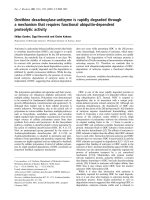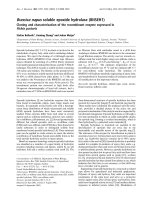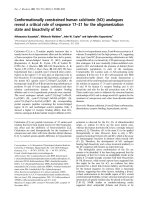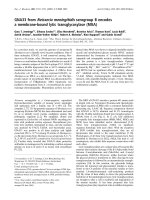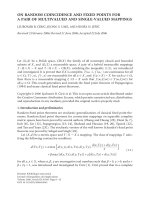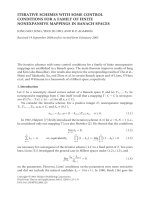Báo cáo y học: " Angiotensin-converting enzyme 2 autoantibodies: further evidence for a role of the renin– angiotensin system in inflammation" potx
Bạn đang xem bản rút gọn của tài liệu. Xem và tải ngay bản đầy đủ của tài liệu tại đây (127.54 KB, 2 trang )
e discovery of the angiotensin-converting enzyme
(ACE) homolog ACE2 [EC 3.4.15.1] has provoked
intensive eff orts to elucidate the role of this enzyme in
various pathologies, including hypertension, diabetes,
heart failure, viral infection, pulmonary injury and liver
fi brosis. e biological relevance of ACE2 refl ects its
critical location in the enzymatic cascade of the renin–
angiotensin system to directly govern the local expression
of angiotensin (Ang) II and Ang-(1–7), two bioactive
hormones with signifi cant and opposing actions.
In the present issue of Arthritis Research & erapy,
Takahashi and colleagues assessed circulating levels of
ACE2 in patients with connective tissue pathologies
including pulmonary hypertension and persistent digital
ischemia [1]. In comparison with normal controls,
patients with overt vasculopathy expressed signifi cantly
higher amounts of ACE2 protein in the circulation. ese
patients, however, exhibited reduced ACE2 activity in
serum and circulating autoantibodies against the enzyme.
ere are few reports on the circulating levels of ACE2 in
humans or experimental models, possibly refl ecting the
diffi culty of obtaining a consistent measure ment of the
enzymatic activity. e current study reveals a potentially
novel mechanism to attenuate the catalytic activity of
ACE2, thereby promoting the infl ammatory actions of
Ang II.
ACE and ACE2 are both chloride-activated metallo-
peptidases that are predominantly associated with the
cell membrane and are widely distributed in various
tissues and vascular beds. In contrast to ACE, which
cleaves two amino acid residues from the carboxyl
terminus of Ang I to form Ang II, ACE2 hydrolyzes a
single amino acid from the carboxyl end of Ang II to form
Ang-(1–7) [2]. ACE is considered the primary enzymatic
pathway that catalyzes the generation of Ang II in the
circulation and tissues. ACE inhibitors, which have
become standard therapies in the treatment of hyper-
tension and other cardiovascular disease, have little or no
inhibitory activity against ACE2, but they reduce the
metabolism of Ang-(1–7) [2]. Circulating levels of ACE
activity are readily measurable in humans and other
species using synthetic substrates or assessing the direct
conversion of Ang I to Ang II.
In comparison with serum ACE, Rice and colleagues
reported that the circulating levels of ACE2 were 100-fold
lower and that <10% (40 out of 494) of their patients
expressed measurable ACE2 activity [3]. Nevertheless,
families with detectable circulating ACE2 exhibited a
greater incidence of cardiovascular pathologies although
the overall sample population was low. More recent
studies by Epelman and colleagues fi nd that circulating
levels of ACE2 are highly associated with increasing
severity of progressive heart failure [4]. However, patients
Abstract
Traditionally viewed as important in the regulation of
blood pressure, the renin–angiotensin system – and
speci cally the angiotensin-converting enzyme (ACE)–
angiotensin (Ang) II–AT
1
receptor axis – may play a
prominent role to promote in ammation and brosis.
ACE2, a new component of the renin–angiotensin
system, has emerged as a key enzyme that selectively
degrades Ang II and generates Ang-(1–7), a bioactive
peptide with anti-in ammatory and anti- brotic
actions. Takahashi and colleagues demonstrate
circulating titers of inhibitory autoantibodies against
ACE2 in patients with systemic sclerosis. The current
study reveals a potentially novel mechanism to
attenuate the catalytic activity of ACE2, thereby
promoting the actions of Ang II.
© 2010 BioMed Central Ltd
Angiotensin-converting enzyme 2 autoantibodies:
further evidence for a role of the renin–
angiotensin system in in ammation
Mark C Chappell*
See related research by Takahashi et al., />EDITORIAL
*Correspondence:
Hypertension and Vascular Disease Center, Wake Forest School of Medicine,
Medical Center Boulevard, Winston-Salem, NC 27015, USA
Chappell Arthritis Research & Therapy 2010, 12:128
/>© 2010 BioMed Central Ltd
were chronically treated with inhibitors of the renin–
angiotensin system including aldosterone antagonists
which may increase basal ACE2 expression potentially
contributing to the protective mechanisms of these
therapies.
ere is increasing evidence for the interplay of the
renin–angiotensin system and infl ammatory events [5].
Pre-eclampsia is associated with circulating autoanti-
bodies against the AT
1
protein that act as functional
receptor agonists to promote vasoconstriction and infl am-
mation [5]. Studies by Harrison and colleagues suggest
that T-cell expression of the AT
1
receptor contributes to
infl ammatory events and the development of hyper-
tension. Moreover, activated T cells may themselves
generate Ang II locally to infl uence cell function in an
autocrine manner [6]. In experimental encephalo myelitis,
AT
1
expression was increased and subsequent AT
1
receptor blockade or ACE inhibition ameliorated the
autoimmune infl ammation [7].
e present fi ndings by Takahashi and colleagues
reveal increased expression of circulating ACE2 in
patients with vasculopathy utilizing a novel protein cap-
ture assay [1]. Despite the increased levels of the enzyme,
ACE2 activity was markedly lower in comparison with
the control group. Indeed, the authors report the
presence of circulating levels of ACE2 antibodies that
exhibit inhibitory activity in vitro. Previous studies
showed that commercial sources of antibodies against
ACE2 also inhibit enzyme activity, suggesting the epitope
may encompass the catalytic site [4]; however, the present
study is the fi rst to identify autoantibodies that attenuate
enzyme activity in a patient population.
e current fi ndings are of potential importance in our
understanding of the role of circulating and tissue
sources of ACE2, particularly in various disease states.
Increased circulating levels of ACE2 may refl ect a
compensatory mechanism to alter the balance of the
renin–angiotensin system to favor the ACE2–
Ang-(1–7)–AT
7
receptor axis and promote the anti-
fi brotic and anti-infl ammatory actions of the hepta-
peptide, as well as attenuate the Ang II–AT
1
receptor
pathway. Clearly, generation of endogenous antibodies
with inhibitory activity against ACE2 may undermine
this compensatory response. Indeed, identifi cation of
endo genous ACE2 inhibitors is important in lieu of
optimizing the therapeutic benefi ts following adminis-
tration of recombinant soluble ACE2, as recently
demonstrated in models of diabetic nephropathy [8] and
liver fi brosis [9] or in the genetic expression of ACE2 in
pulmonary hypertension [10].
Although the ongoing study of the renin–angiotensin
system has now surpassed the century mark, the
characterization of this system and identifi cation of the
factors that regulate the expression or activity of its
components continues to yield novel therapeutic targets
in cardiovascular disease and other pathologies.
Abbreviations
ACE, angiotensin-converting enzyme; Ang, angiotensin.
Acknowledgements
These studies were supported in part by grants from the National Institute of
Health (HL-56973).
Competing interests
The authors declare that they have no competing interests.
Published: 28 June 2010
References
1. Takahashi Y, Haga S, Ishizaka Y, Mimori A: Autoantibodies to angiotensin
converting enzyme 2 in patients with connective tissue diseases. Arthritis
Res Ther 2010, 12:R85.
2. Chappell MC: Emerging evidence for a functional angiotensin-converting
enzyme 2-angiotensin-(1-7) mas receptor axis; more than regulation of
blood pressure? Hypertension 2007, 50:596-599.
3. Rice GI, Jones AL, Grant PJ, Carter AM, Turner AJ, Hooper NM: Circulating
activities of angiotensin-converting enzyme, its homolog, angiotensin-
converting enzyme 2, and neprilysin in a family study. Hypertension 2006,
48:914-920.
4 Epelman S, Tang WHW, Chen SY, Van Lente F, Francis GS, Sen S: Detection of
soluble angiotensin-converting enzyme 2 in heart failure: insights into the
endogenous counter-regulatory pathway of the renin–angiotensin–
aldosterone system. J Am Coll Cardiol 2008, 52:750-754.
5 Verlohren S, Muller DN, Luft FC, Dechend R: Immunology in hypertension,
preeclampsia, and target-organ damage. Hypertension 2009, 54:439-443.
6. Hoch NE, Guzik TJ, Chen W, Deans T, Maalouf SA, Gratze P, Weyand C, Harrison
DG: Regulation of T-cell function by endogenously produced angiotensin
II. Am J Physiol 2009, 296:R208-R216.
7. Platten M, Youssef S, Hur EM, Ho PP, Han MH, Lanz TV, Phillips LK, Goldstein
MJ, Bhat R, Raine CS, Sobel RA, Steinman L: Blocking angiotensin-converting
enzyme induces potent regulatory T cells and modulates TH1- and TH17-
mediated autoimmunity. Proc Natl Acad Sci U S A 2009, 106:14948-14953.
8. Oudit GY, Liu GC, Zhong J, Basu R, Chow FL, Zhou J, Loibner H, Janzek E,
Schuster M, Penninger JM, Herzenberg AM, Kassiri Z, Scholey JW: Human
recombinant ACE2 reduces the progression of diabetic nephropathy.
Diabetes 2010, 59:529-538.
9. Osterreicher CH, Taura K, De Minicis S, Seki E, Penz-Osterreicher M, Kodama Y,
Kluwe J, Schuster M, Oudit GY, Penninger JM, Brenner DA: Angiotensin-
converting-enzyme 2 inhibits liver brosis in mice. Hepatology 2009,
50:929-938.
10. Yamazato Y, Ferreira AJ, Hong KH, Sriramula S, Francis J, Yamazato M, Yuan L,
Bradford CN, Shenoy V, Oh SP, Katovich MJ, Raizada MK: Prevention of
pulmonary hypertension by angiotensin-converting enzyme 2 gene
transfer. Hypertension 2009, 54:365-371.
doi:10.1186/ar3052
Cite this article as: Chappell MC: Angiotensin-converting enzyme 2
autoantibodies: further evidence for a role of the renin–angiotensin system
in in ammation. Arthritis Research & Therapy 2010, 12:128.
Chappell Arthritis Research & Therapy 2010, 12:128
/>Page 2 of 2

